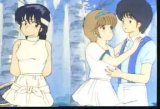

Quick Links:
Kimagure Orange Road, TV Series
Kimagure Orange Road (KOR) has what you want. What I mean by that is that, in KOR, you’ll find the high school you wish you went to, the friends you wish you had, and the world you wish you lived in. It’s a great escape into the not-so-real “real world.”
KOR is basically a love triangle set in a high school in Japan. The male lead, Kyosuke, has just moved to his new town where he meets the beautiful, and capricious, Madoka. Kyosuke immediately falls for Madoka. Madoka might even like Kyosuke… But, because her best friend Hikaru definitely does like him (and lets everyone know it), Madoka won’t make a move. The problem is, Hikaru is really cute and nice, too - she’s bubbly where Madoka is serious - so Kyosuke likes hanging around with Hikaru. And, he’s so indecisive that he can’t just come out and say what he wants.
Due to that indecision, the three actually make great friends. The show is sweet, funny, and puts the innocence back into relationships - something that’s rarely seen now in both anime and live-action works. The three stumble through the pitfalls of relationships like most of us did - they have no experience and do the best they can by just trying to be good people. These themes make the series totally worth watching in and of themselves.
However, there’s a further complication: Kyosuke is an ESPER, just like his two sisters. If anyone finds out that he has “the power,” his family will be forced to move again, and he desperately doesn’t want to move away from Madoka and Hikaru. He is also worried about how the two will think of him if they find out. In other words, cue wacky hijinks. Oddly enough, while the episodes focusing on “the power” are hilarious, I found myself more looking forward to the episodes dealing directly with the relationships, a testimony to the strength of the story written by Izumi Matsumoto in the original manga.
On to the specifics: this is a 48 episode TV series that ran from April 1987 to March 1988. The quality of animation is indicative of the period: don’t expect computer enhanced colors and effects. The quality varies slightly from episode to episode, some having much better art and fluidity than others. The direction and layout remains at a pretty constant level of superior quality. Of special note are the wonderful character designs by Akemi Takada (character designer for Patlabor, Maison Ikkoku, Urusei Yatsura, Creamy Mami, and more). Madoka’s following in Japan is huge - her image adorns every possible item, and Takada’s masterful designs are in many ways responsible for this. In fact, Takada released a new art book this year entitled “Madoka.”
The music for the series was, and still is, unique in the sense that the pop songs used for the opening and ending tracks, as well as during the show, were actual popular songs at the time. Since pop music is often about love and heartbreak, the songs fit the series perfectly. Of course, whether or not you enjoy these particular songs depends primarily on whether you’re a fan of retro music or not. Once again, these are 80’s pop songs. However, the large number of CDs produced from the series underscores the popularity of the music.
Music played an important role in the series itself as Madoka is musically inclined. While not always being able to speak her heart, the jazz riffs she plays on her sax speak eloquently enough. The instrumental music carries both the carefree feeling of being in high school (which those of us who are out of high school can really appreciate) and the frustration of being in high school (which those of you in high school are very familiar with). There is also a pervading sense of melancholy that this wonderful time in their lives can’t last forever. The narration, provided by Kyosuke, has subtle hints that the story is being told in the past tense, but never reveals how the story ends.
Animeigo has done a phenomenal job of subtitling and writing liner notes for the series. This review was based on the laserdisc version of the series, however it is available on VHS tape and Animeigo plans a DVD release in the future.
For those of you confused by the number of different KOR releases, the proper way to view the series is the TV shows first, followed by the OAVs, and then the phenomenal movie KOR: I Want to Return To That Day (this is not to be confused with the KOR movie released by ADV called Summer’s Beginning which picks up years after the end of the first movie). Do not, I repeat, do not view the first movie before the TV series; you’ll ruin everything.
Kimagure Orange Road is simply a classic series. It takes the simple premise of a young love triangle, keeps it clean and fun, throws in some psychic powers to stir up the mix, and always stays fresh and exciting. I have to give it my highest possible recommendation.
Distributor: AnimEigo Creator: Toho / Studio Pierrot Released: 1987
Plot: A+ Character Design: A+ Animation Quality: B Music: A Overall: A+



